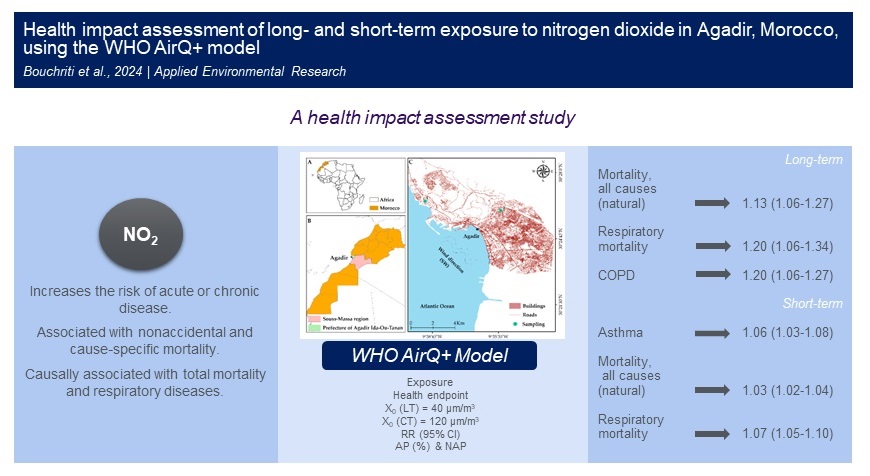Assessing the Short- and Long-Term Health Effects of Nitrogen Dioxide in Agadir, Morocco: A WHO AirQ+ Model Application
Main Article Content
Abstract
Epidemiological studies have revealed that exposure to atmospheric nitrogen dioxide (NO2) increases the risk of acute and chronic diseases. This study used the WHO AirQ model to assess both the short- and long-term impacts of NO2 on human health in the city of Agadir in Morocco. The mean NO2 values were obtained from measurements taken at two locations. This study assessed the long- term health effects of NO2 on natural all-cause mortality (LT-ACM), mortality due to respiratory diseases (LT-RD), and morbidity due to chronic obstructive pulmo-nary disease (LT-COPD), as well as the short-term health impacts of NO2 on natural all-cause mortality (ST-ACM), mortality due to respiratory diseases (ST-RD), and asthma hospitalizations and emergency admissions (ST-A). The attributable proportion (AP) per 10 µg m-3 in adults aged 30 and over in LT-ACM, LT-RD, and LT-CPOD was estimated to be 16.42%, 23.49%, and 23.49%, respectively; the number of attributable cases (NAP) was estimated to be 323, 17, and 11, respectively; and the RRs were estimated to be 1.20 (95% CI: 1.09–1.43), 1.31 (95% CI: 1.09–1.56), and 1.31 (95% CI: 1.09–1.43), respectively. In addition, the AP at 25 µg m-3 for all ages in ST-ACM, ST-RD, and ST-A was estimated to be 17.15%, 9.25%, and 21.45%, respectively, and the NAP was estimated to be 12, 182, and 15, respectively. A significant number of deaths and serious cases of asthma and COPD can be avoided if the NO2 concentrations are below the WHO exposure limits. The findings of this study match those of previous studies on the impact of air pollution on humans. Reducing NO2 emissions from various sources, especially car exhaust, and enhancing monitoring systems are two methods that may significantly mitigate adverse health effects in the population.
Article Details

This work is licensed under a Creative Commons Attribution-NonCommercial 4.0 International License.
Published articles are under the copyright of the Applied Environmental Research effective when the article is accepted for publication thus granting Applied Environmental Research all rights for the work so that both parties may be protected from the consequences of unauthorized use. Partially or totally publication of an article elsewhere is possible only after the consent from the editors.
